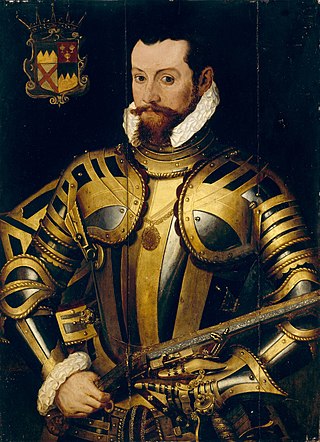
Thomas Butler, 10th Earl of Ormond and 3rd Earl of OssoryPC (Ire), was an influential courtier in London at the court of Elizabeth I. He was Lord Treasurer of Ireland from 1559 to his death. He fought for the crown in the Rough Wooing, the Desmond Rebellions, and Tyrone's Rebellion. He fought his rival, Gerald FitzGerald, 14th Earl of Desmond in the Battle of Affane in 1565.

Gerald FitzGerald, 14th Earl of Desmond, also counted as 15th or 16th, owned large part of the Irish province of Munster. In 1565 he fought the private Battle of Affane against his neighbours, the Butlers. After this, he was for some time detained in the Tower of London. Though the First Desmond Rebellion took place in his absence, he led the Second Desmond Rebellion from 1579 to his death and was therefore called the Rebel Earl. He was attainted in 1582 and went into hiding but was hunted down and killed.
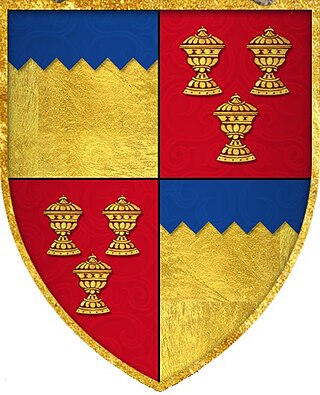
Piers Butler, 8th Earl of Ormond, 1st Earl of Ossory also known as Red Piers, was from the Polestown branch of the Butler family of Ireland. In the succession crisis at the death of Thomas Butler, 7th Earl of Ormond he succeeded to the earldom as heir male, but lost the title in 1528 to Thomas Boleyn. He regained it after Boleyn's death in 1538.
George Feilding, 1st Earl of Desmond was an English nobleman, awarded the title of Earl of Desmond in the Peerage of Ireland by Charles I under the terms of a letter patent issued by James I. He was created Registrar of the Court of Admiralty, for life, in 1625.
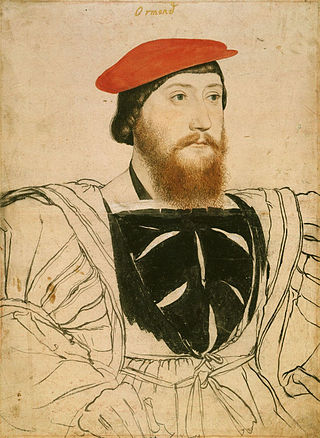
James Butler, 9th Earl of Ormond and 2nd Earl of Ossory, known as the Lame, was in 1541 confirmed as Earl of Ormond thereby ending the dispute over the Ormond earldom between his father, Piers Butler, 8th Earl of Ormond, and Thomas Boleyn, 1st Earl of Wiltshire. Butler died from poison in London.
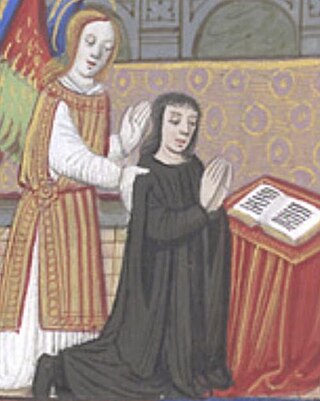
Thomas Butler, 7th Earl of Ormond PC was the youngest son of James Butler, 4th Earl of Ormond. He was attainted, but restored by Henry VII's first Parliament in November 1485, and the statutes made at Westminster, by Edward IV, which declared him and his brothers traitors, were abrogated.
James Butler, 3rd Earl of Ormond, was a noble in the Peerage of Ireland. He acceded to the title in 1382, and built Gowran Castle three years later in 1385 close to the centre of Gowran, making it his usual residence, whence his common epithet, The Earl of Gowran.
James Butler, 1st Earl of Ormond, was a noble in the Peerage of Ireland. He was born in Arklow, Wicklow, Ireland and died in Gowran, Kilkenny, Ireland.
Sir James Butler of Polestown was a warlord in Yorkist Ireland.

Sir Edmund Butler of Cloughgrenan, was an Irish noble and the second son of James Butler, 9th Earl of Ormond and Lady Joan Fitzgerald. He was a scion of the House of Ormond, and a rebel against the Tudors.

Margaret Butler, Countess of Ormond, Countess of Ossory was an Irish noblewoman and a member of the powerful and celebrated FitzGerald dynasty also known as "The Geraldines". She married Piers Butler, 8th Earl of Ormond, by whom she had three sons and six daughters.
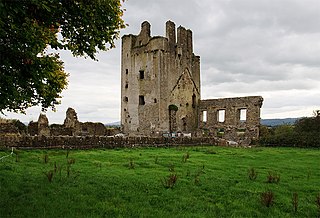
John Butler of Kilcash was an Irish landowner and soldier. A younger son of James Butler, 9th Earl of Ormond and brother of Thomas Butler, 10th Earl of Ormond, he received Kilcash Castle as appanage. He fought in the Desmond–Ormond conflict and was badly wounded in 1563, just before the Battle of Affane. He was the start-point of the Kilcash branch of the Ormonds and the father of Walter Butler, 11th Earl of Ormond.
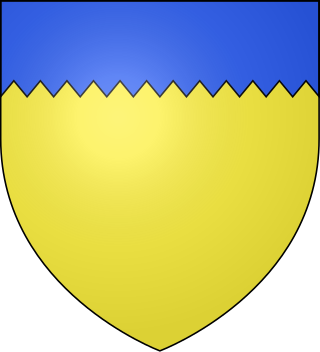
Butler is the name of a noble family whose members were, for several centuries, prominent in the administration of the Lordship of Ireland and the Kingdom of Ireland. They rose to their highest prominence as Dukes of Ormonde. The family has produced multiple titles such as Baron Cahir, Baron Dunboyne, Viscount Ikerrin, Viscount Galmoye, Viscount Mountgarret, Viscount Thurles, Earl of Carrick, Earl of Kilkenny, Earl of Ormond, Earl of Ossory, Marquess of Ormonde and Duke of Ormonde. Variant spellings of the name include le Boteler and le Botiller. The Butlers were descendants of Anglo-Norman lords who participated in the Norman invasion of Ireland in the 12th century. The surname has its origins in the hereditary office of "Butler (cup-bearer) of Ireland", originating with Theobald Walter, 1st Chief Butler of Ireland. The arms of later family members depicted three cups in recognition of their original office.
Richard Butler of Kilcash was an Irish soldier and landowner, the third son of Thomas Butler, Viscount Thurles and brother of James, 1st Duke of Ormonde. He sided with the Irish Confederacy at the Irish Rebellion of 1641. He scouted the enemy on the morning of the Battle of Cloughleagh. His descendants succeeded to the earldom of Ormond when the senior branch of the family failed in 1758.
Sir Richard Preston, 1st Earl of Desmond was a favourite of King James VI and I of Scotland and England. In 1609 the king made him Lord Dingwall. In 1614 he married him to Elizabeth Butler, the only child of Black Tom, the 10th Earl of Ormond. In 1619 he created him Earl of Desmond.
Elizabeth Preston, Countess of Desmond and 2nd Baroness Dingwall was the only daughter of Thomas Butler, 10th Earl of Ormond, called Black Tom, a lone Protestant in his Catholic Old English family. Her marriage and inheritance were manipulated by James I to keep Black Tom's inheritance out of the hands of his Catholic successor, Walter of the beads and bring them into the hands of his Scottish favourite Richard Preston, Lord Dingwall.
John Rochfort was a member of the pre-1801 Parliament of Ireland, in the Irish House of Commons.

Elizabeth Butler, Duchess of Ormond and 2nd Baroness Dingwall reunited the Ormond estate as her maternal grandfather, Black Tom, 10th Earl of Ormond had it, by marrying James Butler, later Duke of Ormond, her second cousin once removed. She had inherited her share of the Ormond estate through her mother, Elizabeth Preston, who was Black Tom's daughter and only surviving child. Her husband had inherited his share from his grandfather Walter Butler, 11th Earl of Ormond, Black Tom's successor in the earldom. Her share was the bigger one and included Kilkenny Castle.
Horace William Noel Rochfort JP DL was an Anglo-Irish landowner and sheriff.
Colonel John Staunton Rochfort was an Anglo-Irish landowner and sheriff.











